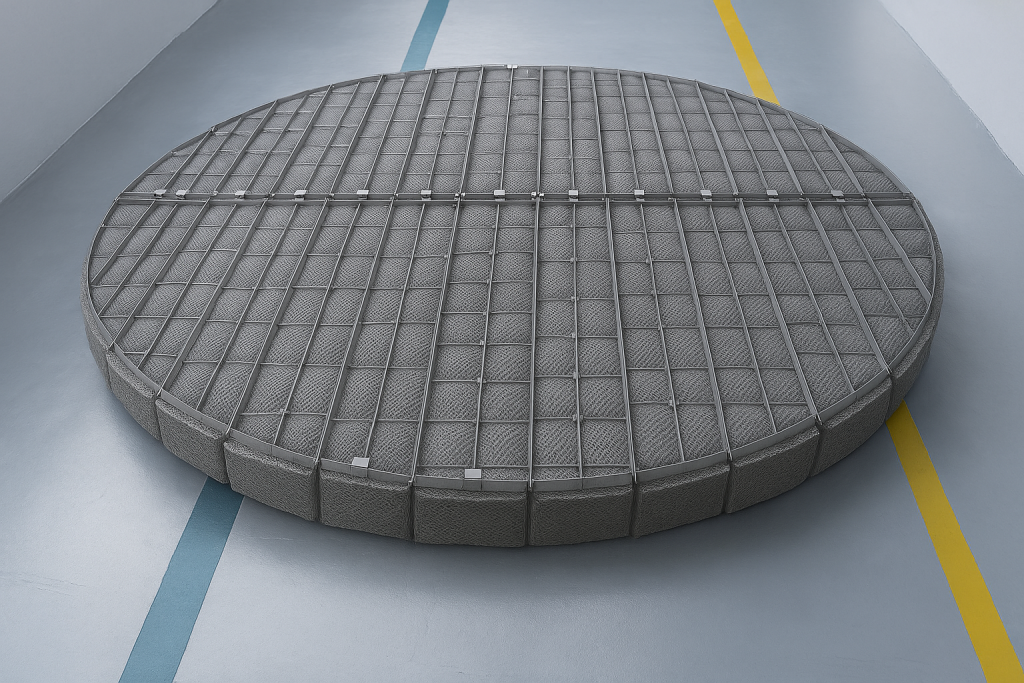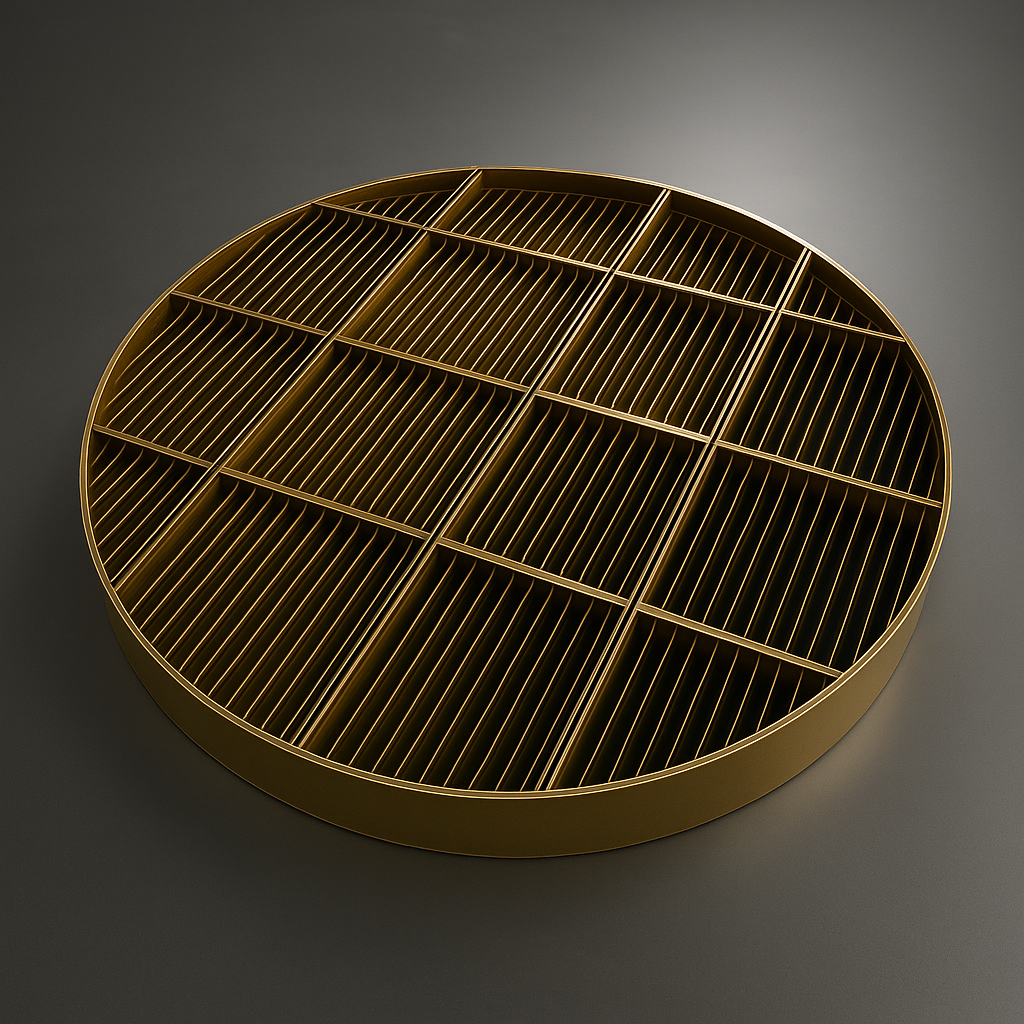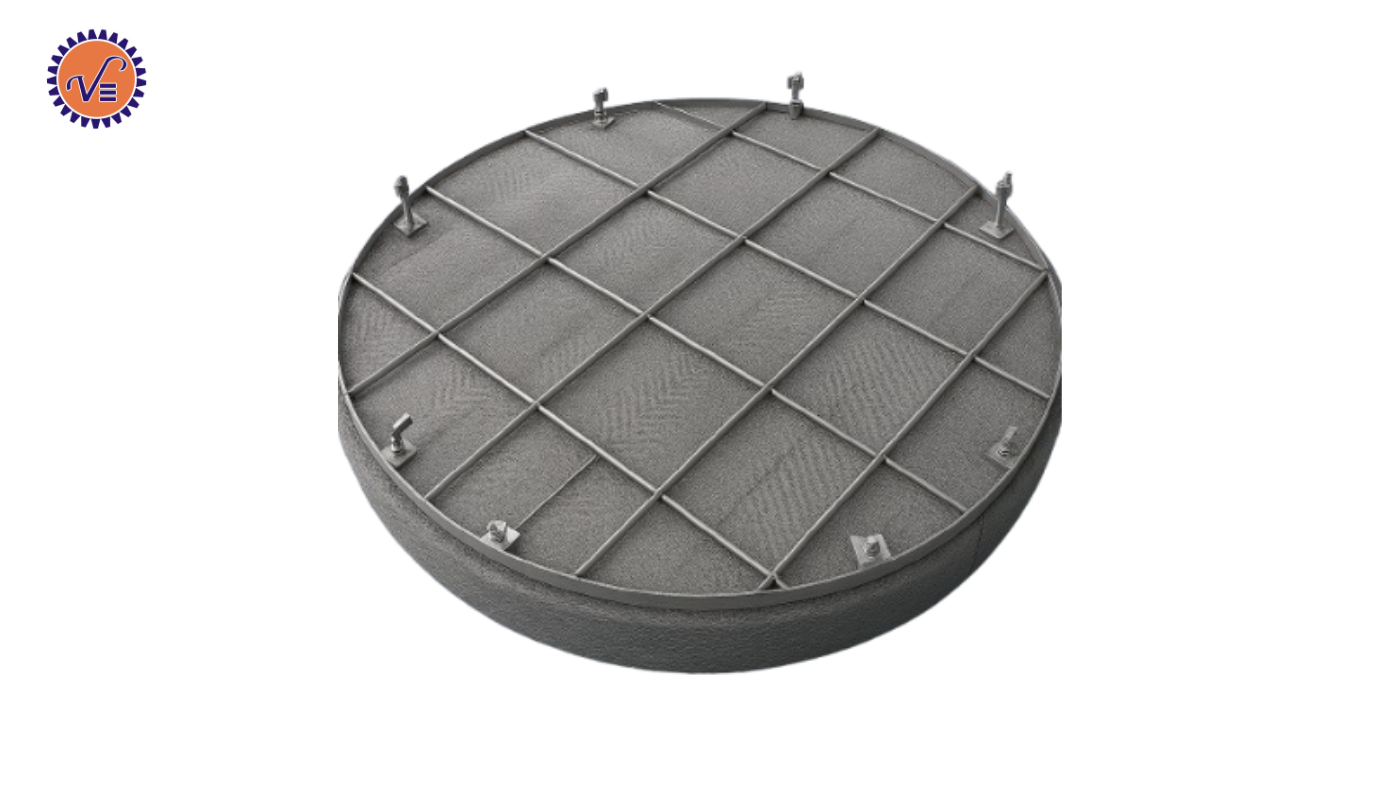What is a Demister Pad?
Imagine a Demister Pad as a giant, fluffy sponge sitting in your gas stream. It’s made of a mesh – think woven wires or fibres that traps liquid droplets as gas flows through it. Picture driving in the rain: water droplets hit your windshield and stick there. That’s kind of how a Demister Pad works. The gas moves through, the droplets get caught on the mesh, and over time, they bunch up and drip down due to gravity, leaving the gas cleaner.
Why People Love Demister Pads
- Affordable: Compared to other fancy separation gadgets, Demister Pads won’t break the bank.
- Easy to Use: You can pop them into almost any vessel size or shape – they’re super flexible.
- Great for Tiny Droplets: These pads shine at grabbing tiny droplets down to 5 microns or even less.
Where They Fall Short
- Clogging Risk: If there’s too much liquid or some pesky solids in the gas, the pad can get gunked up, slowing things down.
- More Maintenance: You might need to clean or swap them out more often, especially if the gas is loaded with stuff.
- Pressure Drop: When they clog, they can make the gas work harder to get through, like blowing through a blocked straw.
Demister Pads are super popular in places like chemical plants or oil refineries. You’ll find them in scrubbers, evaporators, or distillation columns. For instance, in a plant dealing with sulfuric acid, they might use a special corrosion-resistant Demister Pad to tackle acidic mist.

What is a Vane Pack?
Now, let’s switch gears to the Vane Pack. Instead of a mesh, think of it as a series of curvy, zigzagging channels – like a mini obstacle course for your gas. It’s made up of parallel plates or vanes. As the gas flows through, it has to twist and turn. The liquid droplets, being heavier, can’t keep up with the sharp corners. They crash into the vane, stick there, and then slide down to drain away.
Why Vane Packs Rock
- Handles Big Loads: Got a lot of liquid in your gas? Vane Packs can take it without choking.
- Smooth Flow: They don’t slow the gas down much – less pressure drop means your system stays efficient.
- Tough as Nails: Built from sturdy stuff like stainless steel, they can handle rough conditions and high speeds.
The Catch
- Price Tag: They cost more upfront than Demister Pads – a bigger investment to start.
- Not Great with Tiny Drops: Super small droplets might sneak through the vanes without getting caught.
- Space Hog: They’re bulkier, so you’ll need more room to fit them in.
Vane Packs are champs in high-volume setups – think gas turbines or massive oil refinery systems. They’re perfect, where you’ve got a ton of gas moving fast and a decent amount of liquid to deal with. I’ve seen them shine in places like offshore platforms, where durability and low maintenance are must-haves.

Demister Pad vs. Vane Pack: How Do They Stack Up?
Alright, now that we know what each one is, let’s put them head-to-head. Here’s how they compare on the stuff that matters most:
- Efficiency:
- Demister Pads are your go-to for tiny droplets – they’re like a fine net catching the smallest raindrops.
- Vane Packs are better with bigger droplets and heavier liquid loads – more like a coarse sieve.
- Pressure Drop:
- Demister Pads can clog and make the gas push harder, increasing pressure drop.
- Vane Packs keep things flowing easily, with less resistance – a win for energy savings.
- Maintenance:
- Demister Pads need more babysitting – regular cleaning or replacing if they get mucky.
- Vane Packs are low-maintenance – they’re built to last and don’t clog as easily.
- Cost:
- Demister Pads are wallet-friendly upfront – great if you’re on a tight budget.
- Vane Packs cost more to start, but their durability might save you cash over time.
- Space:
- Demister Pads are compact – perfect for squeezing into tight spots.
- Vane Packs need elbow room – better for bigger setups.
Here’s a handy table to see it all at a glance:
| Feature | Demister Pad | Vane Pack |
| Efficiency | Awesome for small droplets | Best for big droplets |
| Pressure Drop | Higher if clogged | Lower, smoother flow |
| Maintenance | More frequent | Less hassle |
| Cost | Cheaper to buy | Pricier but lasts longer |
| Space | Fits anywhere | Needs more room |
| Best For | Smaller flows, fine drops | High flows, heavy loads |
This is just a starting point, though. Your setup might have quirks that tip the scales one way or the other. Let’s dig into what you should think about next.
Factors to Consider When Choosing
Picking between a Demister Pad and a Vane Pack isn’t a coin toss – it’s about matching the tool to your job. Here’s what to mull over:
- Droplet Size: Are you dealing with super tiny droplets? Demister Pads are your friend. Bigger drops? Vane Packs can handle them with no sweat.
- Flow Rate: If your gas is moving fast and furious, a Vane Pack’s low-pressure drop keeps things humming. Slower flows? A Demister Pad might do just fine.
- Liquid Load: Are there tons of liquid in the mix? Vane Packs won’t blink. Lighter loads? Demister Pads can manage without breaking a sweat.
- Solids in the Gas: Got dust or gunk floating around? Vane Packs are less likely to clog up compared to Demister Pads.
- Temperature and Chemicals: Hot or corrosive stuff? Check the materials – both can be made to handle it, but you’ll need the correct specs.
- Budget: Are you short on cash now? Demister Pads are easier on the wallet. Thinking long-term? Vane Packs might save you down the road.
- Space: Tight quarters? Demister Pads slipped right in. More room to play with? Vane Packs can stretch out.
Take a minute to think about your setup. Have you ever noticed your process slowing down or liquid sneaking through where it shouldn’t? That might hint at whether your current gear is up to the task, or if it’s time to switch.
Tips and Tricks for Getting the Most Out of Them
Whichever you pick, a little know-how goes a long way. Here’s some practical advice:
- For Demister Pads:
- Keep an eye on pressure – if it’s creeping up, it might be time to clean or replace.
- If clogging’s a constant headache, maybe tweak your process or think about a Vane Pack instead.
- For Vane Packs:
- Check the vanes now and then – make sure they’re clear of debris to keep performance top-notch.
- If small droplets are slipping through, consider pairing it with a Demister Pad for extra oomph.
Think of it like maintaining your car, a little regular care keeps it running smooth and saves you bigger headaches later.
Wrapping It Up
Choosing between a Demister Pad and a Vane Pack doesn’t have to feel like rocket science. It’s about knowing your needs droplet size, flow rate, liquid load, and budget and matching them to the right solution. Demister Pads bring affordability and finesse to smaller jobs. Vane Packs offer power and staying power for the big leagues. Sometimes, it’s even a combo of both that seals the deal.


